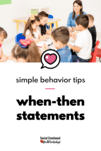Getting a classroom of students or even one student to follow expectations is not an unfamiliar challenge. Every teacher must have a bag of behavior strategies to pull from. Never mind the stickers, the velcro charts, or the punch cards; a simple phrase can help communicate expectations to students. Say hello to the When-Then statement.
What is a When-Then Statement?
A When-Then statement communicates a positive expectation and the positive consequence after students meet that expectation.
You give them expectations and tell them what you will do in return. This type of statement is intended to build trust and break expectations into smaller chunks.
The When-Then statement also leaves room for student choice and should be considered somewhat negotiable. Students can choose not to, but they don't receive the positive consequence.
When you [positive behavior], you can [positive reward/consequence].
What It Isn't
When-Then statements are different than saying if you don't stop this, this will happen. That is negative and likely will cause some students to dig in. This behavior strategy is not intended to give a non-negotiable directive.
Careful to avoid this construction: When you [negative behavior], then [negative consequence] will happen.
How to Use When-Then Statements
Classroom Behavior Strategies
- Keep your tone calm and confident.
- Make sure your expectations are realistic.
- Keep the vocabulary age-appropriate and check for understanding with students.
- Make sure to follow through with positive consequences.
- Let students behind the curtain so they know you are allowing them to make a positive choice.
- Use We. It comes across as less threatening.
Individual Behavior Strategies
- Understand the reason behind the behavior first so you can construct an excellent when-then statement.
- Consider If-Then statements when the choices are less negotiable.
When-Then is an easy strategy to have in your back pocket when encouraging and creating a community of personal responsibility and mutual trust. Remember the rules of simple language, attainable choices, and follow-through while keeping things positive.
Download a When-Then Chart to get started.























It’s a great strategy. We use it in kindergarten, helping children form basic ideas about interacting with others. I can’t think of a better way. And it’s really worth avoiding negative examples, they can be misunderstood by children at this age.